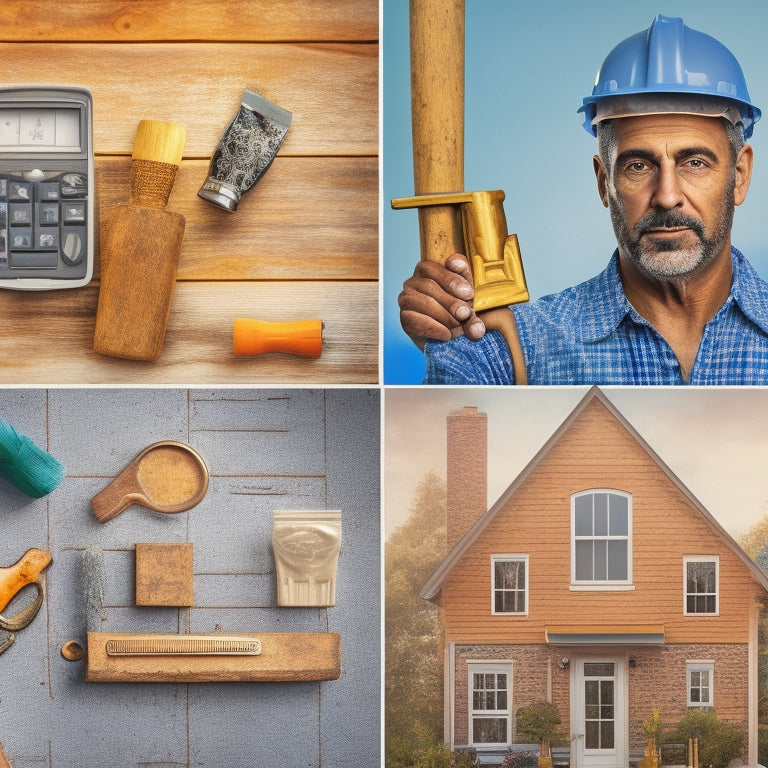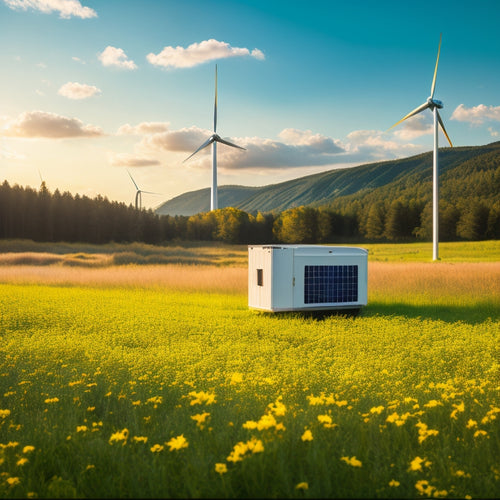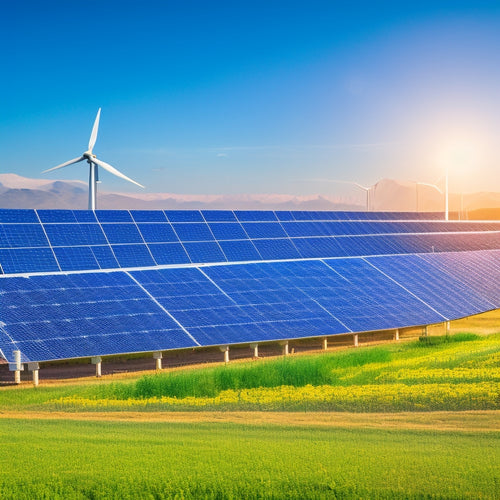
Why DIY Home Improvements Save You Money
Share
By taking on DIY home improvement projects, you can save up to 50% on renovation expenses and increase your property value. These projects often focus on energy efficiency, reducing your energy consumption costs and environmental impact. You'll identify areas of energy waste through home energy audits, and then seal gaps, add insulation, and upgrade to energy-efficient appliances and lighting. These upgrades will not only reduce your utility bills but also contribute to a healthier living environment. As you investigate these cost-saving opportunities, you'll uncover even more ways to optimize your home's energy efficiency and enhance your savings.
Key Takeaways
- DIY projects eliminate labor costs associated with hiring professionals, saving homeowners 20-50% on renovation expenses.
- Energy-efficient upgrades reduce utility bills over time, leading to substantial energy savings and ROI.
- Completing DIY home energy efficiency projects leads to a more energy-efficient home, reducing energy consumption costs.
- Simple changes in lighting, such as replacing incandescent bulbs with LEDs, can significantly lower energy costs.
- Insulating the home retains warm air in winter and cool air in summer, reducing energy loss and consumption costs.
DIY Home Energy Efficiency Projects
Kick-start your DIY home improvement journey by tackling DIY home energy efficiency projects, which can save you a significant amount of money on your utility bills while also reducing your carbon footprint.
Conducting a home energy audit is a great place to start, as it will help you identify areas where energy is being wasted. You'll likely find that gaps and cracks around doors and windows are significant contributors to energy loss.
To maximize your energy savings, it's crucial to calculate daily energy needs by considering all appliances and devices for off-grid system adequacy. Seal these openings with weather stripping to prevent heat from escaping.
Additionally, consider adding insulation to your attic or walls to further reduce heat loss. By tackling these DIY projects, you'll be well on your way to creating a more energy-efficient home.
Reduce Energy Consumption Costs
You can greatly reduce your energy consumption costs by taking a few simple steps.
Insulating your home is a great starting point, as it helps to retain warm air in the winter and cool air in the summer. Consider using sustainable insulation options like recycled denim or natural wool energy efficient materials to minimize heat loss and energy waste.
Additionally, replacing traditional appliances with energy-efficient ones can also make a big impact on your energy bills.
Insulate Your Home
By investing in insulation, you can greatly reduce energy consumption costs and create a more comfortable living space. Insulation materials like fiberglass, cellulose, and spray foam can be used for attic, wall, and basement insulation. Proper insulation techniques, including air sealing and thermal barriers, can prevent heat loss and gain. This reduces the load on your heating and cooling systems, resulting in lower energy bills.
| Insulation Type | Benefits | Application |
|---|---|---|
| Fiberglass | Thermal insulation, soundproofing | Attic, walls, basement |
| Cellulose | Eco-friendly, fire-resistant | Attic, walls |
| Spray Foam | High R-value, air sealing | Walls, basement |
| Radiant Barriers | Reflects heat, reduces cooling costs | Attics, roofs |
| Thermal Barriers | Prevents heat transfer, reduces energy loss | Walls, floors, ceilings |
Use Energy-Efficient Appliances
Replacing traditional appliances with energy-efficient ones can greatly reduce your energy consumption costs, as they employ advanced technology to minimize energy waste.
By making this switch, you'll not only save money on your utility bills, but you may also be eligible for appliance rebates from your utility company or government.
To identify areas for improvement, consider conducting an energy audit of your home to pinpoint which appliances are using the most energy. This will help you prioritize which ones to replace first.
With energy-efficient appliances, you can expect to see significant long-term savings.
Additionally, many energy-efficient appliances come with warranties, providing you with added protection and peace of mind.
Easy DIY Insulation Upgrades
Three key areas in your home where insulation upgrades can make a significant impact are the attic, walls, and floors. By focusing on these areas, you can reduce heat loss in the winter and heat gain in the summer, leading to lower energy bills and a more comfortable living space.
Furthermore, by incorporating high-efficiency solar charging solutions off-grid energy systems and reliable off-grid power systems, you can maximize your energy autonomy and reduce your reliance on non-renewable energy sources.
You can make the following easy DIY insulation upgrades:
- Add insulation to your attic, such as fiberglass batts or cellulose, to reduce heat loss and prevent moisture damage.
- Seal gaps and cracks in your walls with weather stripping or spray foam to prevent air leaks.
- Insulate your floors, especially if you have a crawl space or unheated basement, to reduce heat loss and prevent moisture issues.
- Use reflective insulation to radiate heat back into your home.
- Add insulation to your ducts to improve the efficiency of your heating and cooling system.
Save Money With Smart Windows
One of the most effective ways to save energy and reduce your energy bills is to invest in smart windows.
These innovative windows come equipped with advanced features that allow you to control the amount of sunlight entering your home, reducing the need for artificial lighting.
Additionally, smart windows can be coated with a window film that blocks out UV rays, keeping your home cooler in the summer and warmer in the winter.
This means you'll use less energy to heat and cool your home, leading to significant cost savings.
The smart window benefits are undeniable, and with the added convenience of remote control operation, you'll be able to optimize your energy usage with ease.
DIY Solar Panel Installation
When you install solar panels yourself, you'll need to contemplate the time and labor costs involved, as these can add up quickly.
However, the energy savings potential is significant, and can lead to substantial long-term benefits.
Time and Labor Costs
Installing solar panels yourself can be a cost-effective way to employ renewable energy, but it's vital to factor in the time and labor costs involved.
As you begin this DIY project, you'll need to take into account the hours spent on planning, preparation, and execution. This includes time devoted to:
- Tool selection: choosing the right equipment for the job
- Project planning: designing a layout and ensuring compliance with local regulations
- Roof preparation: ensuring your roof is structurally sound and ready for panel installation
- Panel installation: physically placing the panels on your roof
- Testing and maintenance: verifying the system's functionality and performing routine checks
Energy Savings Potential
Your DIY solar panel installation can greatly reduce your reliance on the grid and your energy bills. By utilizing renewable energy, you'll decrease your consumption of fossil fuels and lower your carbon footprint.
This reduction in energy consumption also complements home weatherization techniques, such as insulation and window sealing, to create a more energy-efficient home. Conducting an energy audit beforehand will help identify areas of energy loss, providing significant understandings for optimization.
With a well-planned DIY solar panel installation, you can expect substantial energy savings and a considerable return on investment. By taking control of your energy needs, you'll enjoy long-term financial benefits and contribute to a more sustainable future.
Low-Cost Energy Efficient Lighting
Many homeowners are surprised to learn that a considerable portion of their energy consumption stems from lighting.
By making a few simple changes, you can considerably reduce your energy costs.
-
Replace traditional incandescent bulbs with LED bulb upgrades, which use up to 90% less energy and last up to 25 times longer.
-
Consider installing lighting automation systems that allow you to control lighting levels and schedules remotely.
-
Use task lighting instead of overhead lighting to reduce energy consumption.
-
Install occupancy sensors that turn lights off when no one is in the room.
-
Use natural light during the day by opening curtains and blinds.
Frequently Asked Questions
Do I Need Professional Experience for DIY Home Improvement Projects?
You don't necessarily need professional experience for DIY home improvement projects, but you'll need to research the tools needed, take necessary safety precautions, and follow instructions carefully to guarantee a successful and safe outcome.
Can I DIY Home Improvements on a Tight Budget?
You're not alone in DIY efforts, as 77% of homeowners undertake projects to save money. On a tight budget, you can still DIY home improvements by opting for budget-friendly materials and investing in essential tools that'll pay off in the long run.
How Long Do DIY Home Improvements Typically Take to Complete?
You'll find that DIY home improvement project duration varies greatly, depending on your skill level and the complexity of the task; on average, simple projects take a few hours to a few days, while more intricate ones can span weeks or even months.
Are DIY Home Improvements Worth the Potential Mess and Chaos?
You're wondering if DIY home improvements are worth the potential mess and chaos? Ironically, they can be, if you're willing to invest time in project planning and excel at time management - the keys to a stress-free, cost-effective renovation.
Can I Claim DIY Home Improvements on My Taxes?
You can claim DIY home improvements on your taxes, potentially increasing tax deductions and enhancing home equity, but make certain you itemize deductions and maintain accurate records of materials, labor, and before-and-after photos to support your claims.
Related Posts
-

Sustainable and Eco-Friendly Generators for a Reduced Carbon Footprint
Sustainable and eco-friendly generators are perfect for cutting your carbon footprint and increasing energy efficienc...
-

The Role of Battery Monitoring Systems in Renewable Energy
Battery monitoring systems play an essential role in renewable energy by enhancing system longevity and optimizing pe...
-

High-Efficiency Solar Battery Chargers for Remote Areas
High-efficiency solar battery chargers are essential for your off-grid energy needs in remote areas. They maximize en...


